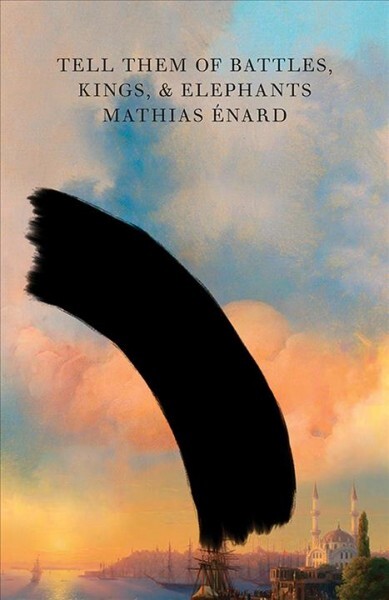Tell Them of Battles Kings and Elephants Review

Tell Them of Battles, Kings, and Elephants
The story, co-ordinate to legend, goes similar this: In 1502, Sultan Bayezid II, ruler of the Ottoman Empire, summons Leonardo da Vinci to construct a bridge that would span the Golden Horn, an inlet between the Turkish cities of Pera and Constantinople (mod twenty-four hours Istanbul). Leonardo's proposed blueprint would be the longest span in the world at that time. Simply the sultan rejects it, arguing that an curvation of that size would surely collapse in the heart. Soon after, Michelangelo Buonarroti is invited to blueprint the same bridge, but he declines the offering.
In Tell Them of Battles, Kings, and Elephants, Mathias Énard imagines what might accept been had Michelangelo accepted. The novel, translated by Charlotte Mandell and originally published in 2010, is comprised of curt, fragmented chapters. Compared to the author'southward 500-plus page, ane-judgement-long novel Zone, it is a masterful practice in brevity. It also kept me guessing, as it moves quickly from one scene to the next, never letting yous get too comfy in one place.
The twelvemonth is 1506, and Michelangelo is immature and highly renowned, most famous for his statue of David, which has made him a hero in Italy. One day, two Franciscan monks show up with a letter from the Sultan, asking that he submit drawings for the span. Overwhelmed by the scale of the job, Michelangelo turns the Franciscans away on three occasions, demanding that they give him time. He knows he is an artist of immense talent, but the magnitude of the project raises doubts in his mind almost whether he is the right person to carry it out. "If the Sultan chose yous, Maestro," 1 of the monks assures him, "that'due south considering you are qualified."
At the time, Michelangelo is working for Pope Julius II, the warlike, disciplinarian pontiff with whom he had a strained relationship. He is frustrated and biting, feeling that Julius has treated him poorly — so much so that Michelangelo has constitute himself paying for supplies from his ain pocket because of the Pope'southward cheapskate ways. Énard'due south engaging tone makes information technology piece of cake to sympathize with the young artist's insecurities — besides as his growing ambition.
Soon Michelangelo finds out that the sultan has rejected drawings from da Vinci, more than 20 years his senior. The monk, perhaps unknowingly, finds simply the right words to pique his interest: "Yous will surpass him in celebrity if y'all accept, for you will succeed where he has failed, and you lot will requite the world a monument without equal ..."
He is immediately seized past the possibility of transcending a behemothic, and in plough, proving his own skill and superiority. What'due south more, the sultan offers Michelangelo five times what the Pope paid him for two years of work. And so he agrees, setting off on a 6-day boat expedition to Constantinople.
Énard's descriptions consistently dazzle throughout this short volume: "The perfume of rose and jasmine, augmented by evening, mingled with the ocean air and the less poetic effluvia of the urban center." He has a knack for making seemingly mundane details feel meaningful — and I found myself rereading passages that, while simple on the surface, contain layers near his subject's grapheme: "Michelangelo is afraid of love just as he's afraid of Hell."
Michelangelo sits around for three days, occasionally going for a walk merely more often than not cartoon, waiting. When the time comes for him to go to work, he is provided with all he needs for the do of his fine art, from endless supplies to draftsmen and engineers and a large furnished studio. "Here are your kingdom and your subjects," one of his guides tells him. The people gaze at Michelangelo in awe, "the way one looks at a bomb whose fuse has been lit." Merely things presently take a turn, as pain, anger, and ultimately tragedy combine to thwart our hero's cracking plans.
Énard weaves an imaginative and suspenseful tale of civilizations and personalities clashing, of honey, of being an artist in a violent era, of enthralling "what ifs," and of the figurative — and perhaps literal — burning of bridges and connections. As the novel is grounded in concrete facts, what I honey best is how well Énard manages to blur the lines of truth and fiction. The volume'southward afterword lists all the real-life texts, events, and people that characteristic in his story. In one of my favorite scenes of the book, a young translator calls one of Michelangelo's drawings a "miracle." "A miracle?" replies Michelangelo. "No, my friend. It'south pure genius." Énard's prose is brilliant and elliptical, and his novel, like the sculptor's intricate designs, is a true achievement in form.
Juan Vidal is a writer and critic for NPR Books. He'south on Twitter: @itsjuanlove
Source: https://www.npr.org/2018/12/02/671719391/tell-them-of-battles-kings-and-michelangelo-on-the-bosporus